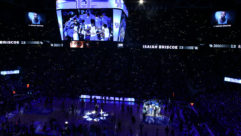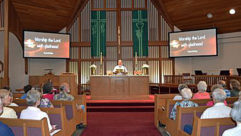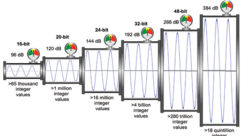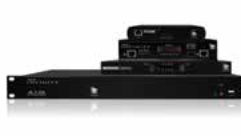
Picture This: The Shape of Things to Come?
Mar 1, 2004 12:00 PM,
By Jeff Sauer
NEC WT600 projector
Who do you think has the thinnest flat-panel display on the market? Panasonic, or NEC with a 3½-inches deep plasma monitor? How about Sony, which has one that’s just 3⅜ inches? Some LCD panels are even thinner, like LG Electronics’ 3.3-inch-deep, 23-inch-wide model. Samsung’s 24-inch panel is less than 3 inches deep if it’s mounted on a wall, though the base is bigger. Thin? Sure, but a projection screen is less than a millimeter deep. Even the frame that secures it to the wall might be only an inch thick or so. When you get down to it, there’s nothing thinner than projection. Shine it on the wall, and the display is as thin as light.All right, front projection has its logistical drawbacks, too. The unit often sits out in the middle of the room on a conference table. Or if it’s mounted on the ceiling or on a back wall, there’s still the potentially annoying problem of individuals, including a presenter, blocking the light path and causing shadows. A rear-projection TV monitor solves those problems but not without getting back to something that’s not all that thin (though InFocus and RCA/Thompson partnered to develop and show an impressive 7-inch-deep rear-projection television at CES in January). In fact, rear-projection monitors with mirrors or optics can get closer to a screen than a traditional front projector.On the other hand, why can’t front projectors sit the same distance from the screen as the light source in those rear-projection monitors? Now one can: NEC’s WT600. It might just change the way a lot of manufacturers, installers, and users think about front projection.AN ODD LITTLE BOXThe WT600 essentially takes a rear-projection light path, turns it around, and puts it in front of the screen. The result is arguably the weirdest-looking projector you’ve seen yet; it looks like a cross between an overhead projector and an old Victrola. It has two handles on top for lugging around the 13-pound, boxy chassis, and it has a retro grille panel across the entire back (or is it the front?) facade. More interesting, it has an 8½-by-7-inch panel on top that flips up, and on the inside of that panel is a curved mirror that reflects the light and image onto a screen that can be literally touching the base of the projector.It’s the first lensless projector, and instead of traditional optics, it uses a series of four curved mirrors to produce a conventional 4:3 rectangular image even though it’s projecting at an extreme angle. The WT600’s chassis has a footprint of 15 inches wide by about 12 inches deep. If the front edge of that chassis is physically touching the screen or is directly below it, the image produced is roughly 33 diagonal inches. Move the projector back a mere 18 inches, and the diagonal image balloons up to a marvelous 80 inches. (The WT600 has no zoom function, because physically moving it so little does so much.)How is the picture from this first-generation anomaly? In a word, it’s mixed. First, it’s just 1500 lumens, and that is almost embarrassingly low for any other of today’s 13-pound projectors. It’s a DLP-based unit, and the contrast ratio is good. Advertised at 3000:1 full on/off, it’s not nearly as impressive against an ANSI checkerboard (92:1 by my light meter). It does have typically good NEC color, yet the image is a little soft in places, and that’s clearly a function of the curved mirrors and curious light path.The more obvious shortcoming of the WT600 is that, in this first version, NEC has not completely solved the pincushion problem created by the curved mirrors and the severe projection angle. In fact, the amount of pincushioning and where it manifests itself varies depending on the size/distance of the projected image. To NEC’s credit, the WT600 features built-in menu functions — even a dedicated 3D Reform button on the remote control and unit top — to adjust keystone, cornerstone, and pincushion. If you spend a little time, you can probably get an image that’s pretty close to right angles. Of course,“pretty close” in this age of projection technology is not terribly impressive.However, none of that is really to the point with the WT600, at least not in the big picture.FINDING NEMOI have two young children, and from time to time, they enjoy the luxury of watching a movie or video on a projector. Knowing that “Daddy tests projectors,” they may appreciate more about projectors than just about any 2- and 4-year-olds alive. They know they shouldn’t look into the light, they know about the cables, and the older one even knows about the remote and the buttons on a variety of models. Still, there are the inevitable forgetful moments when they walk through the light path and, worse, times when the temptation of the forbidden becomes too much. Their little heads turn slightly and their eyes reach for the corner of their eyes in the hopes of seeing the mysterious taboo light. Their father will bark at them to not look and they will quickly move on.But for Finding Nemo, the WT600 made a father’s worry moot. There was no way for these two boys to walk in front of or look into the light of a projector that was virtually touching the wall. There was also no table set on in the middle of the room and no cables running from the wall outlet to that table. It was a little like a rear-projection TV but without the rear projector being an immovable monolith that takes up a large portion of the living room. They also saw a picture as large (or as small) as it needed to be.Naturally, for all of those reasons, NEC is likely to make a home-theater version of the WT600 in one of its next revisions, particularly because rear projection is making a strong move to satisfy the consumer thirst for big and thin, what with the prohibitive price of large-screen plasma or LCD TVs. I know of at least one other company that’s already working on a similarly oriented projector — a model shown in a back room at the CES show.Yet the design is not only for home use. Business and corporate installations suffer from many of the same drawbacks from traditional front projection, rear projection, and thin panels. For example, children or not, a presenter standing in the light path still creates shadows (and possibility even gets temporarily blinded by an inadvertent look into the light). Boardroom designers don’t generally want a projector sitting on the main conference table taking up space, and ceiling installations can be difficult in existing rooms and edifices. Also, giving up space to a large footprint rear-projection monitor is not ideal. Even at NEC’s first-generation, adopter price of $5,995, the WT600 is still a bargain compared with a 60- or 76-inch plasma monitor. Although you’ll eventually need to replace the lamp, burn-in isn’t going to be a problem.A RETRO FUTURE?With the WT600’s price, it won’t be a bestseller. But that’s all right for now. There will likely be enough customers for whom it solves a real problem for NEC (and others) to push forward with some fine-tuning and to produce a second version. Let’s hope so. The relative affordability of front projectors, especially for the screen size, leaves thin-panel solutions far behind. A projector that could sit on something the size of an end table against a wall and that could open on demand — be it for movies or sporting events, business presentations, or boardroom spreadsheets — is potentially a compelling alternative to those other existing solutions.For all those presenters who stand in the light and make shadows in a conference room; for all those boardrooms where installing a rear-projection monitor into the wall or building out a new wall doesn’t make sense; for all those for whom a 60-inch or 76-inch plasma monitor is just too expensive but they still want or need a large presentation image; and for all those who like “thin,” the retro look of the WT600 may be the shape of the future.Jeff Sauerwrites the “Picture This” column for Sound & Video Contractor and is a contributing editor for Video Systems. He’s a video producer, an industry consultant, and director of the Desktop Video Group, a video and computer products testing lab in Cambridge, Massachusetts. He can be reached at[email protected].










